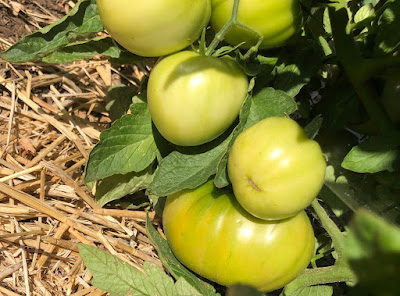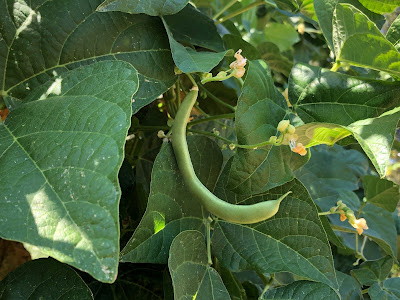
|
|
Is that watermelon ready to be picked? Some investigative work would be necessary
to answer that. (Photos: Kathy Morrison)
|
It depends on what it is and sometimes why it's being grown
The first vegetable garden I remember is the patch my mother planted when I was in kindergarten. I don't recall much about it other than the carrots: My 3-year-old sister and I were so excited about growing carrots that we kept pulling them up to see how big they were -- and then putting them back in the ground.
So much for the carrot harvest.
It can be tough even for adult vegetable gardeners to determine when the crop is ready to harvest. Is that melon ripe? Will those beans get any bigger, or should they be picked now?
Experience is the best teacher here, but if you're a first-timer -- or growing a certain crop for the first time -- these tips might come in handy:

|
|
The bottom tomato will be the first to ripen -- notice
the slight change in color.
|
-- Tomatoes. They generally acquire color as they ripen, turning just a bit soft near the stem end. And they should come off the vine easily; if you have to tug, wait another day or so. But what if they get knocked off the plant while they're still green? The tomatoes can be salvaged by placing them in a single layer in a paper box and covered with newspaper, or they can be enclosed in a paper bag. A ripe banana or apple in there with the tomatoes will help, too. The ethylene gas that the tomatoes and fruit release helps speed up the ripening process. Keep the box or bag in a warm, dry spot and check on it occasionally.
-- Melons and watermelons. This may be the toughest category for determining ripeness. It's heartbreaking to grow a full-size watermelon, only to discover you've picked it too soon, since melons won't ripen further after picking. (Been there!) Muskmelons are the easiest to tell, since they develop a tan color under their netting and they smell amazing. They also start to "slip" (develop a slight crack) at the point where they're attached to the vine. For honeydew melons, which don't "slip," look for the blossom end to soften and start to turn yellow.
Watermelons give off more subtle signals: The skin tends to become rough as they mature, and the "ground spot" underneath turns slightly yellow. The tendrils closest to the fruit dry up. Another test: In the early morning, rap the side of the fruit with your knuckles. A light or metallic sound means it's still green; a dull sound means it's ripe. (This test isn't as effective in the heat of the day.)
-- Cucumbers. They can picked when at least 2 inches long or any time after that until they turn yellow, but it will depend on the variety. Armenian cucumbers are long and skinny well before they're ready to be picked. If you're going to pickle your cucumbers whole, figure out what size you want and watch the crop closely.

|
That bean looks perfect for picking.
|
-- Beans, peppers and summer squash. I put these together because you can pick and enjoy them at any stage of growth. It just depends on how you intend to use them. Tiny pattypan squash are perfect for steaming, but let them grow to 4 or more inches across if you want to make a meal out of one. (Remember: A big squash means big seeds.) Green beans are at their peak when they're 3 inches or more long and still slender, but the mature "bumpy" ones can be roasted successfully. When tiny, hot peppers make great appetizers, but they can be left on the plant to turn red. Bell peppers are typically green before turning red or orange or yellow or purple.
When in doubt, check the seed package or an online listing for the variety of vegetable. These usually list average harvest times; factor in Sacramento's temperature spikes. (Oh, and carrots take about 90 days to grow to harvest size. If only we'd known.)



